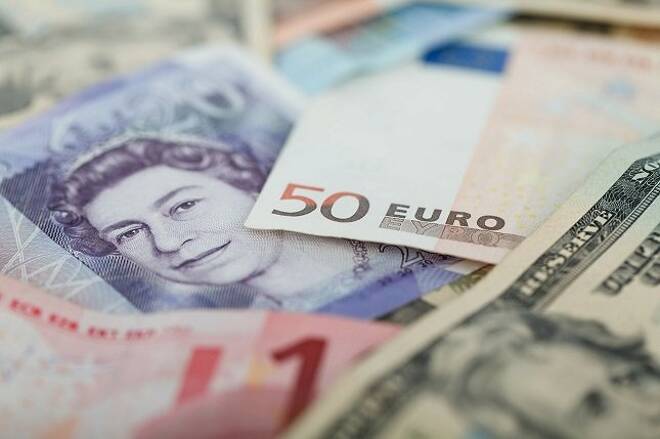Advertisement
Advertisement
EUR/USD Daily Technical Analysis for April 12, 2017
By:
The EUR/USD was nearly unchanged on Tuesday as yields whipsawed followed mixed European data. Riskier assets in the U.S. initially tumbled pushing yields
The EUR/USD was nearly unchanged on Tuesday as yields whipsawed followed mixed European data. Riskier assets in the U.S. initially tumbled pushing yields lower, which weighed on the dollar, but as stock rebounded late in the North American trading session, The Euro lost ground.
Technicals
The EUR/USD tested resistance near the 10-day moving average but was unable to make enough headway forming a doji pattern. This reflects indecision, as the currency pair opened where it closed. Support is seen near the weekly lows at 1.0570, and then the March lows at 1.04934. Momentum remains negative as the MACD (moving average convergence divergence) index prints in the red with a downward sloping trajectory which points to a lower exchange rate.
The hourly chart of the Euro to the US Dollar shows that the exchange rate was unable to recapture resistance which was former support near the lows made on the 5th of April near 1.0628. Support is seen near the lows on the 9th and 10th near 1.0569. This new range appears to be hold, as investors await a new impetus to drive the currency pair.
Eurozone Industrial Production Dropped in February
Eurozone industrial production dropped -0.3% month over month in February, largely due to a -4.7% month over month decline in energy production, which came after a 2.0% month over month rise in January and to a large extend reflects weather conditions over the first two months of the year. So, the unexpected contraction doesn’t necessarily mean a slowdown in underlying growth conditions and the annual rate bounced back to 1.2% year over year from just 0.2% year over year reported initially. Still, with January revised down, the three months’ trend rate slowed to just 0.0% in February from 0.7% in the three months to January, and compared to 0.9% quarter over quarter in Q4 last year.
French Polls continue to Change
The polls in France continue to change, as Melenchon overtakes Fillon in latest French poll. The latest Ifop poll for the first round of the French Presidential election April 23 confirms the trend already seen yesterday, namely that Le Pen and Macron are falling back, while leftist EU critic Melenchon is catching up. The Ifop poll Tuesday showed Le Pen and Macron down 2.5% points compared to the last poll at 24% and 23% respectively. Decisively though, unlike the polls so far Fillon is no longer in third place, but leftist EU critic Melenchon has overtaken him and is now polling 19%. So far nothing has changed and Macron and Le Pen are set to go through to the second round, where Macron is tipped to win with a large margin. However, is Melenchon also manages to overtake Macron, the contest would be between two EU critics from either side of the spectrum, difficult to call and poison for markets.
Fed Banks Want Higher Rates
The Fed Discount rate minutes showed that 9 of the 12 Reserve Banks requested a 25 basis points hike to 1.5% at the March 6 meeting. Those Banks included Cleveland, Dallas, Boston, Philly, Richmond, Chicago, and KC, while 5 banks requested no change in the rate, including NY, Atlanta, SF, St Louis, and Minneapolis. The Directors judged the economy would continue to expand at a solid pace. Inflation was seen remaining below the 2% target. Several, however, expressed uncertainty over fiscal and other governmental policies. Of course we know the FOMC ended up tightening policy on March 15.
U.S. NFIB small business index fell another 0.6 points to 104.7 in March after slipping that amount in February to 105.3 from January’s 105.9. But it’s a fourth straight month in triple digits and it remains above the 102.5 6-month average. The index took big jumps after the election, rising 3.5 points in November and 7.4 points in December. January’s print was the highest going back to December 2004 at 106.1 and compares to the record high of 107.4 from November 2004. Most of the components were flat to lower, though the percentage of firms reporting increased capital spending rose to 29%.
U.S. Chain Store Sales Rebounded
U.S. chain store sales rebounded 2.0% in the week ended April 8, according to The Retail Economist, following a 1.7% drop previously as the index continues its saw-toothed trend. On an annual basis, sales are up 0.4% year over year versus -0.3% year over year. Easter is late this year, and so far this month, Easter related, and spring merchandise sales have been soft. But, sales should pick up this week ahead of the Easter weekend.
About the Author
David Beckerauthor
David Becker focuses his attention on various consulting and portfolio management activities at Fortuity LLC, where he currently provides oversight for a multimillion-dollar portfolio consisting of commodities, debt, equities, real estate, and more.
Advertisement
